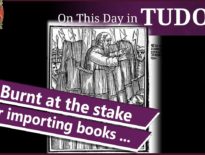On this day in Tudor history, 28th November 1565, member of Parliament and political agent Francis Yaxley set sail for Scotland from Antwerp. Sadly, Yaxley's ship was wrecked in a storm and he never reached Scotland, and neither did the gold he was carrying to Mary, Queen of Scots.
But why was he carrying gold and who was it from? What happened to the gold? Find out all about Yaxley, how he came to be travelling from Antwerp to Scotland, and what happened to him and the gold, in today's talk.
Also on this day in Tudor history, 28th November 1499, Edward Plantagenet, styled Earl of Warwick, was executed by beheading on Tower Hill. Warwick was a potential claimant to the throne being the son of George, Duke of Clarence, brother of Kings Edward IV and Richard III, but it was his involvement in a plot by pretender Perkin Warbeck that was his final undoing.
Find out more about his short and sad life, much of it spent in prison, in last year’s video:
Also on this day in history:
- 1489 – Birth of Margaret Tudor, Queen of Scotland and consort of James IV, at Westminster Palace. Margaret was the eldest daughter of Henry VII and his wife, Elizabeth of York, and the sister of Henry VIII. She spent her childhood at Sheen and at Eltham Palace, but was sent to Scotland at the age of thirteen to marry James IV.
- 1557 – Death of Sir Robert Rochester, administrator. He was buried at the Charterhouse at Sheen. Rochester served Mary I as Comptroller of the Royal Household, Privy Councillor, Chancellor of the Duchy of Lancaster, Keeper of the Privy Seal and a member of Parliament.
- 1584 – Sir Christopher Hatton, as government spokesman, spoke to Parliament on the dangers of Spain, in a speech lasting 'above two hours'.
- 1609 – Death of Sir Thomas Smith, Chief Secretary to Robert Devereux, 2nd Earl of Essex, at his home at Parson's Green in Fulham, London. He was buried at Fulham Church.
Transcript:
On this day in Tudor history, 28th November 1565, member of Parliament and political agent Francis Yaxley set sail for Scotland from Antwerp. Unfortunately, he never reached Scotland. He drowned when his ship foundered off the coast of Northumberland.
Yaxley was not all that was lost in this shipwreck, he was also carrying gold – 20,000 crowns.
But why? Who was it for? Who was Yaxley? And what happened to the gold?
Let me tell you more about this Englishman and the gold he was carrying to Scotland…
• Francis Yaxley was the eldest son of Richard Yaxley of Mellis in Suffolk, and his wife, Anne Austin. The family seat was Yaxley Hall
• Nothing is known of Yaxley’s early life, but he was married to Margaret Hastings, daughter of Sir Henry Hastings of Braunstone in Leicestershire.
• It is thought that he owed his introduction to court in 1547, when he started working for the privy council, to the patronage of William Cecil, the future Baron Burghley.
• Yaxley also served as a Member of Parliament, for Dunwich in 1553, then Stamford in 1555, and Saltash in 1558.
• In the early 1550s, Yaxley worked as a junior diplomat, and he also entered Gray’s Inn, one of London’s inns of the court.
• Catholic Yaxley’s English court career came to a halt when Elizabeth I came to the throne in 1558, and he ended up spending time in prison in 1561 for airing his views on a marriage between Robert Dudley and the queen. He was back in prison in 1562 after being involved with Margaret Douglas, Countess Lennox, in plans to arrange a marriage between her son, Henry Stewart, Lord Darnley, and Mary, Queen of Scots.
• By July 1565, Yaxley was out of prison and was on his way to Flanders. He wasn’t there long, for on 20th August he set sail for Scotland. He arrived there safely on 25th August, having come close to being intercepted by an English man-of-war which had been in pursuit. On his arrival, he was made secretary to Lord Darnley, who had married Mary, Queen of Scots, the previous month. He was now working for Scotland, and on 16th September 1565 he set sail for Spain, having been appointed by Mary as her ambassador at the Spanish court. He arrived at Segovia just over a month later. His mission was to get Philip II to intercede with Elizabeth I to get the Countess of Lennox released from the Tower, to get Philip to persuade Elizabeth not to support Mary’s enemies, and to get him to help, both financially and with manpower, the removal of rebels and heretics supported by the English government from Scotland.
Although Philip wouldn’t intercede with Elizabeth, he was willing to support Mary financially. He arranged for Yaxley to pick up 20,000 crowns in Brussels from his factor, Alonso del Canto.
• On 10th November, Spanish diplomat Guzmán de Silva, wrote to Philip of Spain from Brussel telling him of Yaxley’s arrival the previous night. He went on to say that Yaxley had immediately set off for Antwerp, “followed by Alonso del Canto who will send him off with all needful secrecy and speed” and also with a cipher, which would allow him to communicate with de Silva on Scottish matters.
• Yaxley set sail from Antwerp on this day in history, 28th November 1565, but although de Silva reported how del Canto told him that Yaxley “had embarked in good weather”, the weather soon changed. Unfortunately, a storm caused Yaxley’s ship to be wrecked off the coast of Northumberland. Yaxley was drowned and his body was washed up on Holy Island.
• But what about the gold crowns?
Well, on 28th January 1566, de Silva, who had just arrived in London, reported to Philip “The description given of the man who was found drowned confirms my suspicion, but not as to the finding of the money in the box, as he did not carry one, but only some bundles of blankets for greater secrecy as I am informed by Alonso del Canto”.
Then, on 4th February 1566, de Silva wrote “The wreck and loss of Francis Yaxley is further confirmed, whereat I am greatly grieved as there is no mention of papers or anything.”
Finally, on 29th April 1566, de Silva reported that the Earl of Northumberland had had a dispute with the Admiral, presumably Edward Clinton, Lord High Admiral, “respecting the money which was found in the sea at his port, and which they say was the money taken by Yaxley, the queen of Scotland's man.” So, the gold had been found and seized by Elizabeth’s treasury. De Silva did go on to say, though, that “It is thought the money will be returned to the queen of Scotland.” I’m not sure whether it was.
• Yaxley’s body was transported to Suffolk, where he was buried at Yaxley. He died childless and left his lands in Suffolk to his father, Richard.



Yaxley left on November 10th, but we do not know the name of the ship.
Was there any evidence of an encounter with an English coastal patrol ship?
I am skeptical that he was shipwrecked after a storm.